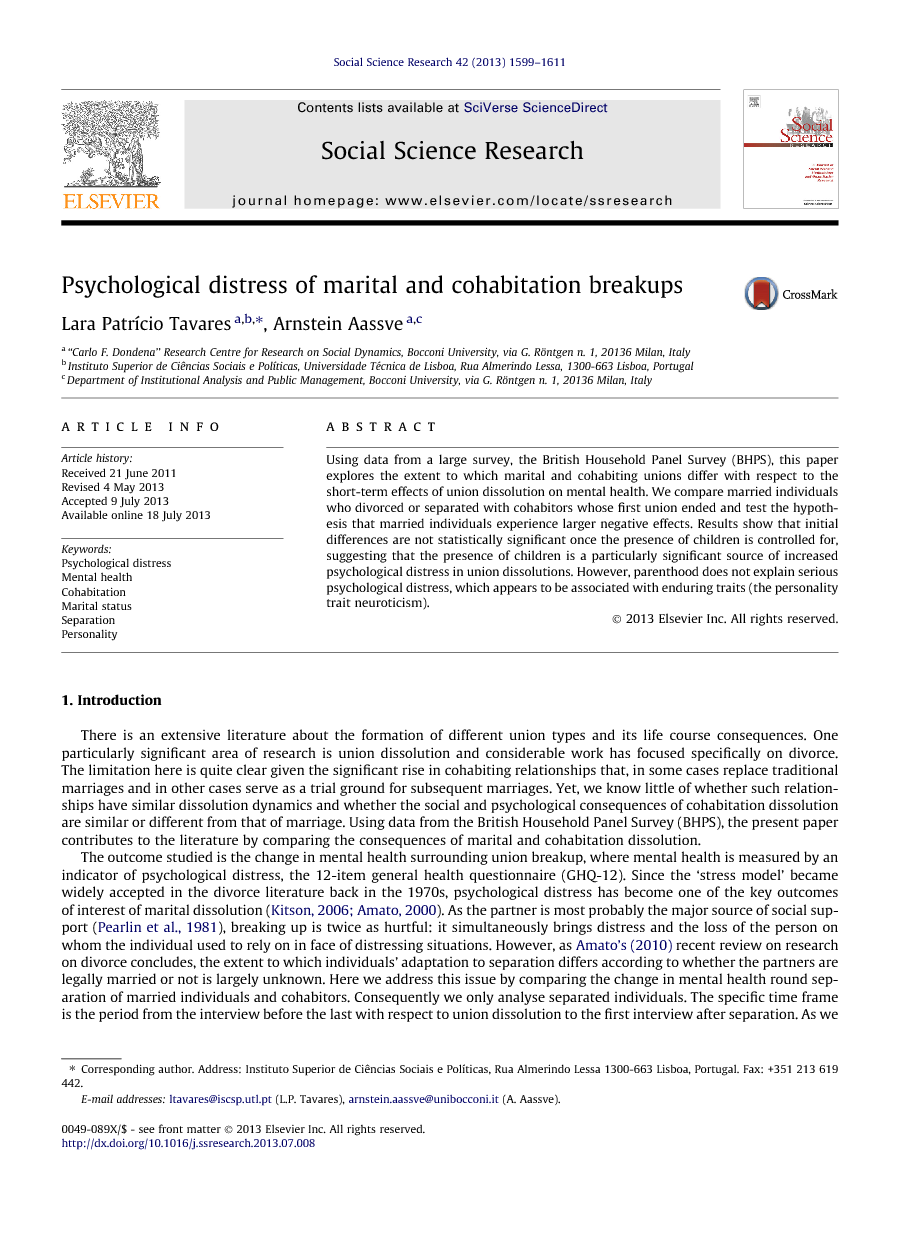ابعاد کنترل روانشناختی والدین: ارتباطات با پرخاشگری فیزیکی و رابطه پیش دبستانی در روسیه
| کد مقاله | سال انتشار | تعداد صفحات مقاله انگلیسی |
|---|---|---|
| 34133 | 2013 | 13 صفحه PDF |

Publisher : Elsevier - Science Direct (الزویر - ساینس دایرکت)
Journal : Social Science Research, Volume 42, Issue 6, November 2013, Pages 1599–1611
چکیده انگلیسی
Using data from a large survey, the British Household Panel Survey (BHPS), this paper explores the extent to which marital and cohabiting unions differ with respect to the short-term effects of union dissolution on mental health. We compare married individuals who divorced or separated with cohabitors whose first union ended and test the hypothesis that married individuals experience larger negative effects. Results show that initial differences are not statistically significant once the presence of children is controlled for, suggesting that the presence of children is a particularly significant source of increased psychological distress in union dissolutions. However, parenthood does not explain serious psychological distress, which appears to be associated with enduring traits (the personality trait neuroticism).
مقدمه انگلیسی
There is an extensive literature about the formation of different union types and its life course consequences. One particularly significant area of research is union dissolution and considerable work has focused specifically on divorce. The limitation here is quite clear given the significant rise in cohabiting relationships that, in some cases replace traditional marriages and in other cases serve as a trial ground for subsequent marriages. Yet, we know little of whether such relationships have similar dissolution dynamics and whether the social and psychological consequences of cohabitation dissolution are similar or different from that of marriage. Using data from the British Household Panel Survey (BHPS), the present paper contributes to the literature by comparing the consequences of marital and cohabitation dissolution. The outcome studied is the change in mental health surrounding union breakup, where mental health is measured by an indicator of psychological distress, the 12-item general health questionnaire (GHQ-12). Since the ‘stress model’ became widely accepted in the divorce literature back in the 1970s, psychological distress has become one of the key outcomes of interest of marital dissolution (Kitson, 2006 and Amato, 2000). As the partner is most probably the major source of social support (Pearlin et al., 1981), breaking up is twice as hurtful: it simultaneously brings distress and the loss of the person on whom the individual used to rely on in face of distressing situations. However, as Amato’s (2010) recent review on research on divorce concludes, the extent to which individuals’ adaptation to separation differs according to whether the partners are legally married or not is largely unknown. Here we address this issue by comparing the change in mental health round separation of married individuals and cohabitors. Consequently we only analyse separated individuals. The specific time frame is the period from the interview before the last with respect to union dissolution to the first interview after separation. As we consider a narrow time-window, the expression ‘psychological distress of union dissolution’ used throughout the paper refers to the observed changes in psychological distress which we attribute to union dissolution. In other words, we are interested in direct effects and not in the effects of stressors that arise as consequences of separation – such as economic hardship, for example. Given the rising trend of cohabitation, focusing exclusively on marital dissolution results in an increasingly partial picture of what happens when unions dissolve. Cohabitation has been increasing dramatically over recent decades across most Western countries. In the UK the number of cohabiting couple families climbed from 1.4 million in 1996 to 2.3 million in 2006 corresponding to an increase from 9% to 14% of all family types (Office for National Statistics, 2007). In the US the number of unmarried couples cohabiting more than doubled from 1990 to 2009 (Simmons and O’Connell, 2003 and Kreider, 2010) and just between 2009 and 2010 there was a 13% increase with the number of cohabiting couples reaching 7.5 million (Kreider, 2010).1 Moreover, there is an increasing likelihood that first cohabiting unions end rather than convert into marriage (Murphy, 2000). In this context, gaining insight about how the dissolution of first cohabiting unions compares with that of first marriages is particularly relevant. There is an ongoing debate in sociology and demography about the extent to which the benefits of being in a partnership are specific to marriages, or whether they also exist in cohabitations. Using this debate as a starting point, we discuss why we may observe a difference in the psychological distress of union dissolution between married individuals and cohabitors. One explanation for this difference is that the end of a union brings the loss of the benefits of being in a partnership, which might differ for marital and cohabiting unions. Another explanation for that difference between married people and cohabitors is that it results from factors other than union type. We then elaborate on the role of two potential confounders, education and parenthood, and how these might simultaneously be associated with union type and ‘reaction’ to union dissolution. We also discuss why we deem particularly important to control for psychological distress before union dissolution and personality traits when analysing changes in mental health. If, after controlling for these factors, the difference in the psychological distress of breakup between married individuals and cohabitors is substantially reduced, that would be evidence that it is not the type of union in itself which matters the most.

